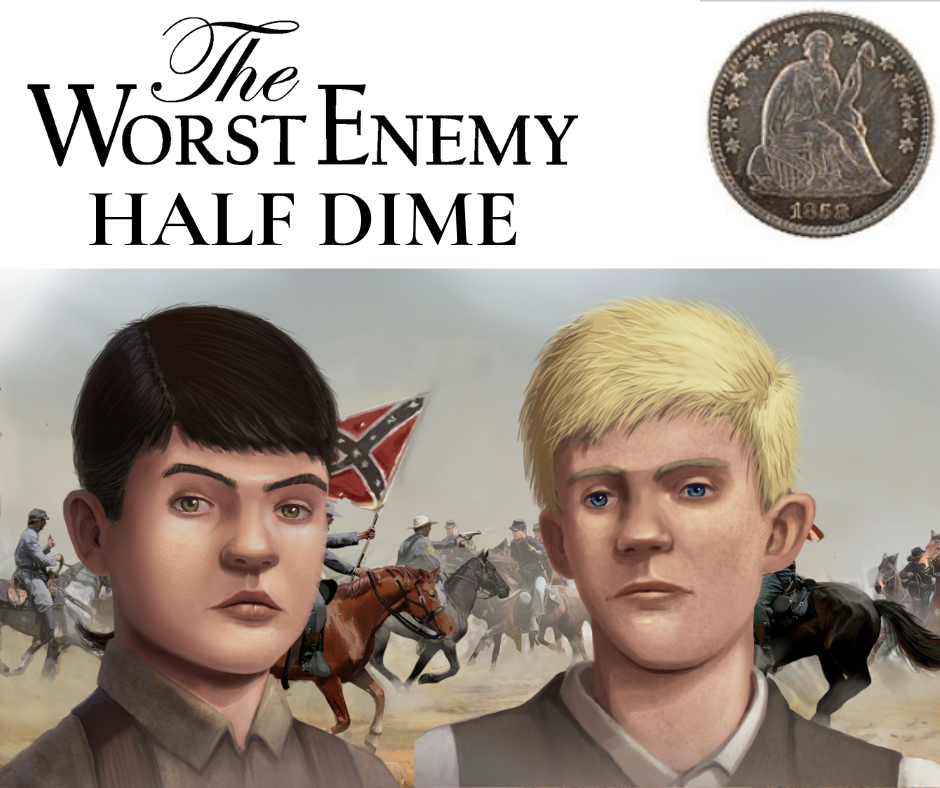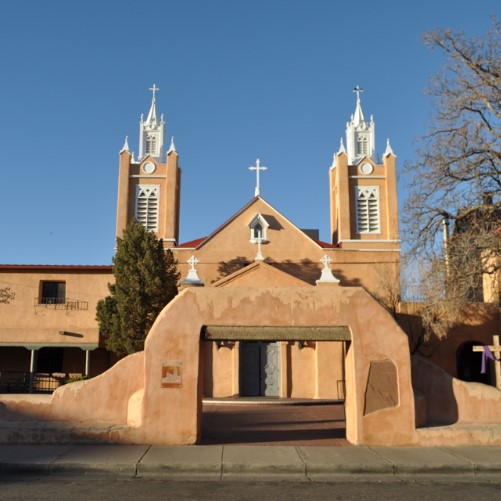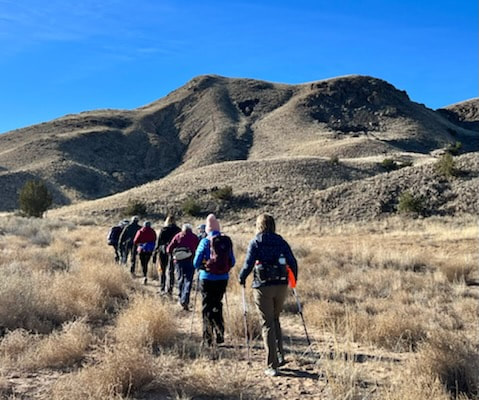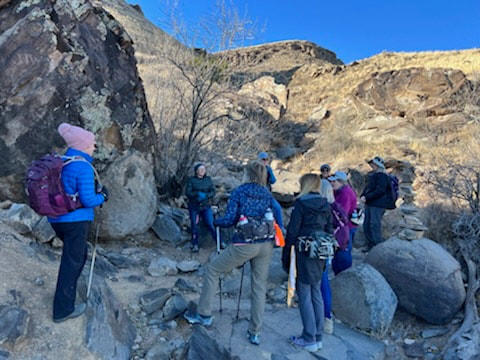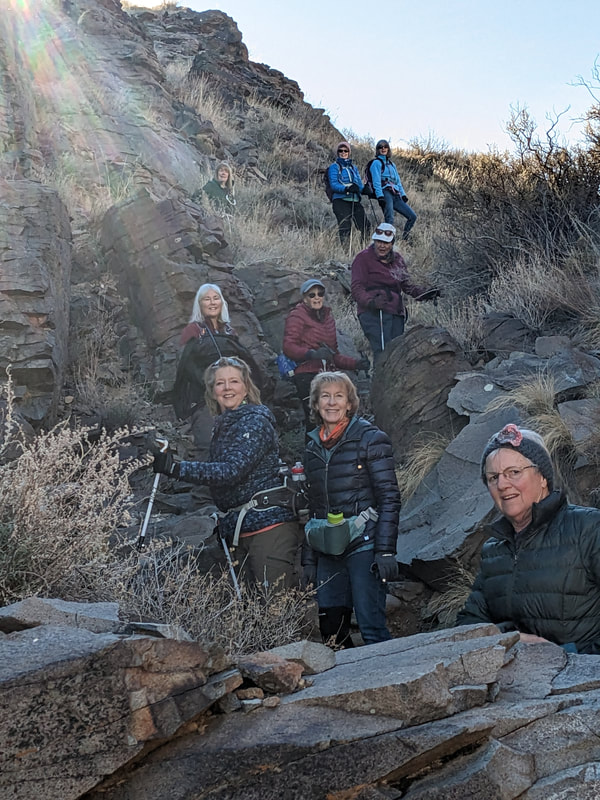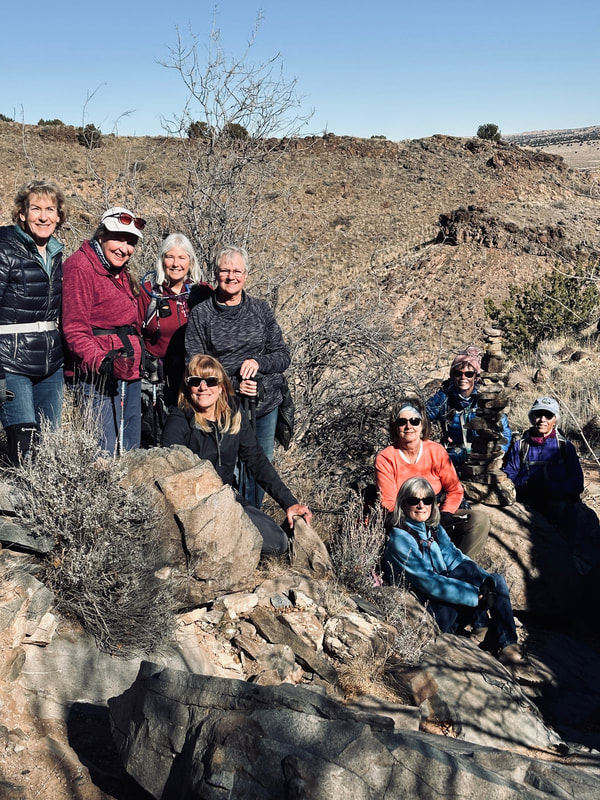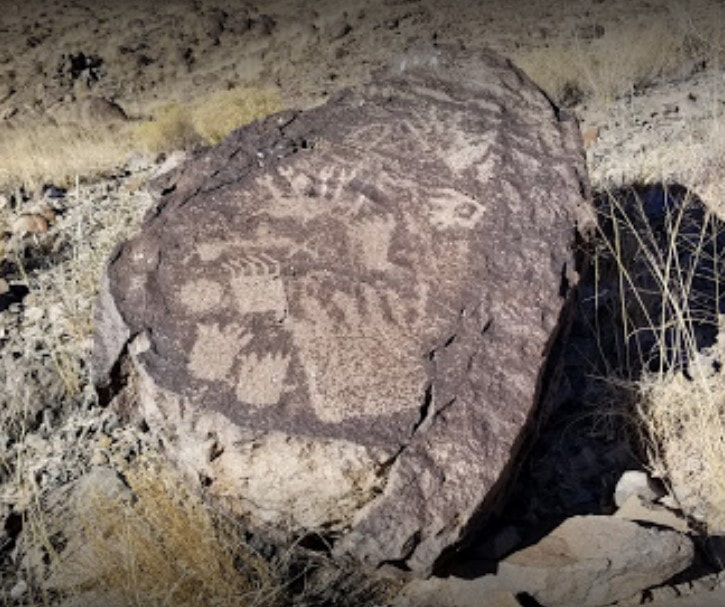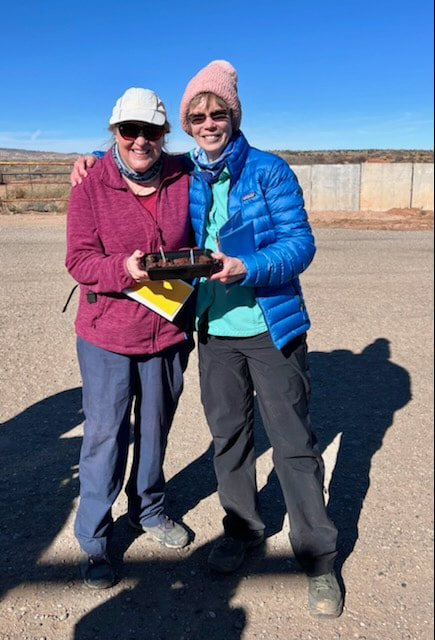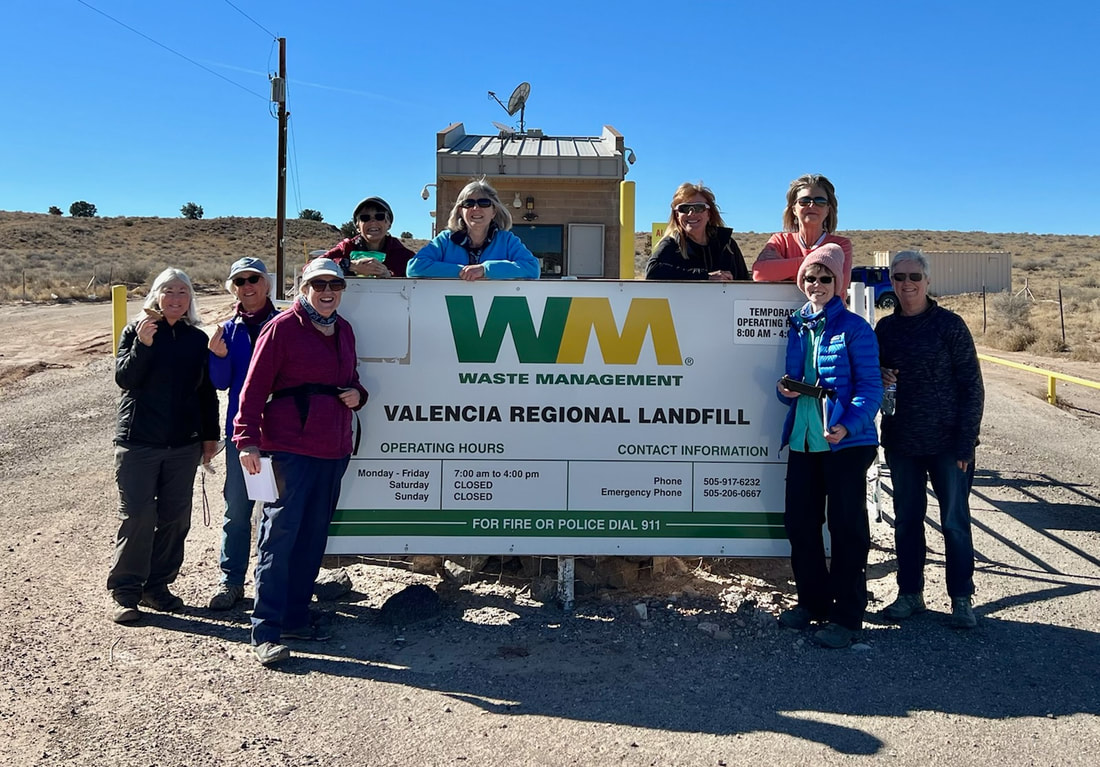
|
Sometimes the most interesting but unknown places are hidden within plain sight. That is certainly true of Albuquerque's Chainsaw Sculpture Garden. Located off Montano, just east of Coors Blvd, the sculpture garden is one of the trailheads for the Paseo del Bosque hiking system. It includes picnic tables and a public restroom. The address is 4100 Montaño Rd NW, Albuquerque, NM 87120. The story of how this sculpture garden came to be is an interesting one. In 2003, some teenagers were playing with fireworks when they inadvertently sparked a wildfire in the bosque. The fire spread to over 250 acres and damaged a lot of land and trails along the riverfront. One of the firefighter who helped to put out the blazes was named Mark Chavez. Chaves is a chainsaw artist in his free time, and thought that turning the charred cottonwood trunks into sculpture honors both the natural beauty of the Southwest and the fire itself. One of the sculptures depicts an eagle rising like a phoenix from the flames.k Another shows a firefighter, perhaps a self-portrait (?) standing upon a slain dragon. This is more significant if you know that the word “dragon” is what being firemen call especially bad fires. There are also sculptures of coyotes, beavers, fish, turtles, roadrunners and cranes, all animals who live in the area. And to remind children to stay out of arroyos, there's a sculpture of La Llorona, the legendary ghost/witch who drowns children who go where they shouldn't, unless a firefighter or other hero rescues them. If visiting the sculpture garden is not enough, you can continue your adventure with a walk along the Paseo del Bosque trail, a 16-mile multi-use trail that runs through the cottonwood forest that follows the banks of the Rio Grande.  When she's not hiking, Jennifer Bohnhoff is writing. The author of over a dozen books, many of which are historical fiction for middle grade readers through adults, Bohnhoff lives in the mountains east of Albuquerque. You can read more about her and her books on her website.
0 Comments
 La Glorieta today. It was originally built sometime before 1803. John Phelan, CC BY-SA 3.0 La Glorieta today. It was originally built sometime before 1803. John Phelan, CC BY-SA 3.0 The Battle of Albuquerque was one of the least significant battles of the American Civil War. It was so small that it is more appropriately called a skirmish. General H.H. Sibley’s Army of New Mexico had begun with great intentions. Its leader had planned to take the California and Colorado goldfields at little cost to the Confederacy, fulfilling a Southern version of Manifest Destiny. But things went wrong from the start, and they soon discovered that New Mexicans were not as willing to feed and shelter an army made up of Texans as Sibley had supposed. After its supply train was destroyed while they were fighting the Battle of Glorieta Pass, Sibley’s army retreated to Santa Fe and began straggling into Albuquerque, where they commandeered La Glorieta, the already old hacienda that was owned by German entrepreneur Franz Huning.  Col. E.R.S. Canby Col. E.R.S. Canby Meanwhile, Col. Canby, whose troops had been bottled up in Fort Craig and living on half rations, moved his men north, leaving Kit Carson and his New Mexico Volunteers to defend the fort. On April 8, Canby arrived at the small farming settlement of Barelas, south of Albuquerque. Scouting reports informed him that the main Rebel force had not yet arrived from Santa Fe and only a small group of Confederates held the town. Canby decided to use his four pieces of artillery to make what he called a “noisy demonstration.” Rebel cannons returned fire from Huning's grist mill, which was located near what is now the intersection of Laguna and Central. The artillery duel lasted for several hours until a delegation of concerned citizens approached Canby under a white flag. They explained that Sibley had refused to allow the town’s women and children to evacuate, and the Union shelling was endangering them. Rather than risk public opinion in a territory that wasn’t wholly supportive of American rule, Canby ordered his men to stop firing, ending the Battle of Albuquerque. The townspeople and the Confederates didn’t know it was over, however. They waited anxiously as the sunset glowed red, orange and pink. In the fading light, the yellow glow of Canyby’s campfires dotted the horizon. Union buglers, drummers and fifers played “Tattoo” marking the end of the day, then continued with more music as, gradually, the campfires died out. It wasn’t until morning that it became apparent that Canby and his troops had slipped away in the darkness, leaving the musicians and the campfires to cover their movement. Unwilling to face Sibley’s entire army, which might reach Albuquerque at any moment, Canby had moved his men eastward into the Sandia Mountains. A few days later in the little village of San Antonio, he met up with the Colorado volunteers now under the command of John Chivington. Now, he thought, his troops were large enough to resume the attack on Gen. Sibley. 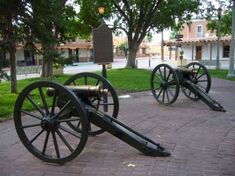 The howitzer replicas, Old Town Albuquerque The howitzer replicas, Old Town Albuquerque But Sibley’s forces had left Albuquerque, ending a possible second act of the Battle of Albuquerque. The General had arrived in Albuquerque soon after the artillery exchange and explained to his officers that, with only enough food for 15 days and no more than 40 rounds of ammunition per man, the best course of action would be to retreat down the Rio Grande valley and return to Texas. So that they couldn’t be used against his retreating troops, he had eight brass howitzers buried in a corral behind San Felipe Neri Church. On the morning of April 12, Sibley abandoned his wounded and proceeded south. The two armies would not encounter each other until two days later, at the Battle of Peralta. Although hardly a battle, the artillery duel is the only battle ever to be fought within the city limits of Albuquerque. The eight brass howitzers were later recovered, and two are preserved in The Albuquerque Museum and replicas of the guns stand around the edges of Albuquerque's Old Town Plaza..  Jennifer Bohnhoff taught New Mexico history at Desert Ridge and Edgewood Middle Schools, in central New Mexico. She is now a full time author and lecturer. Rebels Along the Rio Grande is her trilogy of historical fiction set in New Mexico, and is suitable for middle grade through adult readers. Where Duty Calls and The Worst Enemy are already published. The third and final book in the trilogy, The Famished Country, will be released in October. The Battle of Albuquerque will be depicted in that book. People who recognize the name Bill Mauldin most often remember him as the cartoonist who created Willie and Joe, the enlisted soldiers who showed us the human side of World War II. New Mexico is proud to claim him as one of its talented sons. Mauldin was born October 29, 1921 in Mountain Park, New Mexico, an unincorporated community in Otero County, west of Cloudcroft. His family moved to Phoenix, where he attended Union High School and joined the ROTC, and experience that served him well in the military. Mauldin should have graduated in 1939, but he lacked the credits to do so. Since the editor of the school newspaper and his art teacher recognized his talent and suggested Mauldin pursue cartooning as a profession, he moved to Chicago and took a cartooning course at the Chicago Academy of Fine Arts, then moved back to Phoenix, where he gained a few commissions for election cartoons and joined the Arizona National Guard, 45th Infantry Division. Two days after Mauldin was sworn in, the Guard was "federalized" and the troops moved to Oklahoma. Mauldin soon talked his way into being the cartoonist for the 45th Division News when he was off-duty. He created Willie and Joe for the 45th Division News in 1940. The 45th Division headed to Italy in time to participate in D-Day in Sicily on July 10, 1943. When the newspaper began issuing editions on mimeograph paper, Mauldin learned how to cut drawings into stencils. Willie and Joe began appearing in the Mediterranean edition of the Stars and Stripes in November 1943. By early 1944, they were syndicated as Up Front by United Feature Service. Not happy with being segregated from his unit like most of the news staff was, Mauldin volunteered for gunning duty. He made sure he spent time with K Company, his fellow infantrymen. Near Cassino at Christmas in 1943, he was struck by a small fragment from a German mortar while sketching at the front. Although he said that he had "been cut worse sneaking through barbed-wire fences in New Mexico,", he earned a Purple Heart for his injury. One person who didn’t appreciate Mauldin’s cartoons was General George Patton, who thought Willie and Joe were scruffy and badly mannered. In March 1945, he drove to Patton's quarters in Luxembourg, where the General harangued him: "Sergeant," he said, "I don't know what you think you're trying to do, but the krauts ought to pin a medal on you for helping them mess up discipline for us." Mauldin was permitted to speak his mind to Patton. He later told Will Lang, the Life magazine journalist that “Patton had received me courteously, had expressed his feelings about my work, and had given me the opportunity to say a few words myself. I didn't think I had convinced him of anything, and I didn't think he had changed my mind much, either." In 1945, the war ended and Mauldin won his first Pulitzer for cartooning, prompting his high school to decide that he had done enough work to earn a high school diploma. Mauldin’s post war cartoons first focused on the difficulties that Willie and Joe had reentering American culture. By 1948, Maulding had progressed beyond the plight of Willie and Joe and he was attacking inequality and injustice elsewhere in society. The same stubbornness that allowed him to face General Patton allowed him to take on the FBI, Joseph McCarthy, the House Un-American Activities Committee, and the Ku Klux Klan. When the Vietnam War began, Mauldin talked the Chicago Sun-Times into sending him to Vietnam, arguing that as a cartoon commentator he owed it to his readers to get "his own feet wet." He was visiting his eldest son Bruce, who was a warrant officer and helicopter pilot with the 52nd U.S. Army Aviation Battalion stationed two hundred miles north of Saigon when he experienced a Viet Cong attack on February 7, 1965. He sent back several cartoons about the experience. In 1991, and injury to his drawing hand that forced Mauldin to retire. By 2002, he had developed advanced Alzheimer's Disease. Bill Mauldin died on January 22, 2003 and was buried six days later, at Arlington National Cemetery. He truly is a New Mexican treasure. Jennifer Bohnhoff is a New Mexican who hasn't yet attained treasure status, but it working hard to get there. She is the author of 11 books, many of which are set in New Mexico or involve the trials of war. She is also the daughter and mother of men who have served in the Army.
To commemorate Veteran's Day this year, she is giving away a 1945 copy of Up Front by Bill Mauldin. All of the cartoons in this blog are from that book. The winner will be chosen from among the subscribers to her email list. If you would like to join that list for a chance to win the book, click here.  Coins aren’t common currency anymore. In these days of debit and credit cards, most people don’t carry a pocketful of change. When they do, they find that cashiers don’t know what to do with coins. Computerized cash registers have made counting back change a lost skill. But most of us still recognize coins. Pennies and dimes haven’t changed much in the past few years. The nickel got a bit of an update, with a larger, half forward facing Thomas Jefferson replacing the old side view. Quarters frequently change, with women and states replacing the eagle. Even with these changes of design, most Americans over the age of five can identify their country’s coinage. America had some coins in the past that are no longer minted. The half dime is one of them.  The half dime, or half disme (pronounced deem), was a silver coin that had a value of five cents. It might have been the first coin struck by the United States Mint under the Coinage Act of 1792; some experts consider those first strikes to be practice pieces and therefore not real coins. It is a small coin, half the size of a ten-cent piece. Through the years, the pictures on the half dime changed. Early coins had a picture of the face of Liberty, her hair flowing backwards as if she were making great progress. By the 1830s, Liberty’s face had been replaced by a full Liberty seated on a rock (Plymouth Rock? I found no sources that told me.) and holding a shield. 84,828,478 Seated Liberty half dimes were struck for circulation in the mints at Philadelphia, San Francisco and New Orleans between 1837 and 1873. In the 1860s, the use of nickel to replace silver in coinage became a popular lobbying point. In 1865m tge treasury became producing a new three cent coin made out of a copper-nickel alloy. The following year, a five cent pieces was added to American coinage. This new coin was larger than the silver half dime and less easily lost, making it the more popular of the two redundant coins. The half dime was discontinued in 1873. In The Worst Enemy, Raul Atencio gives Jemmy Martin a half dime as payment for caring for his brother Arsenio. Since the Confederate soldiers and their teamsters had not been paid since leaving Texas, a half dime was a rare and useful gift. Later in the book, Jemmy uses that coin to pay for something that might save another boy’s life.  Jennifer Bohnhoff is a former middle and high school teacher who now writes novels for adults and middle grade readers. The Worst Enemy, is book 2 of Rebels Along the Rio Grande, her middle grade trilogy set in New Mexico during the Civil War. It is scheduled for release by Kinkajou Press, a division of Artemesia Publishing, on August 15, 2023 but can be preordered on Bookshop.  The first book in the series, Where Duty Calls, was a finalist for both the New Mexico Presswomen's Zia Award and the Western Writers of America's Spur Award. It can be ordered in paperback or ebook here. A free, downloadable teachers guide is available through the publisher. Book three, tentatively titled The Famished Country, will be published in spring of 2024. 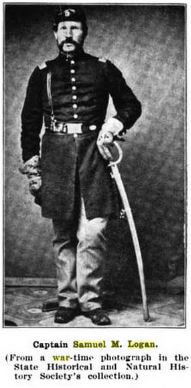 Samuel M. Logan isn’t a name that many would recognize as a Civil War personality, but he played an important supporting role in the Colorado Volunteers and has a small role in my novel The Worst Enemy, the second of three books in Rebels Along the Rio Grande. Little is known about his childhood. Military records suggest he was born on December 18, 1821 in Ohio, who the names of his parents and whether he had any siblings is unknown. Samuel M. Logan was a Mexican American War veteran who was working as a blacksmith in Denver when the Civil War broke out. He didn’t waste any time in showing on which side his sympathies lay with a grand gesture. On April 24, 1861, just days after the bombardment of Fort Sumter, the southern sympathizers who owned Wallingford and Murphey’s Mercantile on Larimer Street in downtown Denver raised the Confederate stars and bars on the pole atop their building. The flag attracted an angry mob of pro-Union sympathizers who threw rocks at the store and demanded that the flag come down.  The Worst Enemy Illustration by Ian Bristow The Worst Enemy Illustration by Ian Bristow Logan swang into action -- literally. He climbed a hitching rail and swung himself onto the roof of the store. Accounts of what happened next contradict each other. Some accounts say that the Marshal showed up at this point, dispersed the crowd, and allowed Wallingford and Murphey to continue flying the Confederate colors. Other accounts say that Logan pulled down the flag and ripped it to shreds as the crowd cheered him on. Whichever is the case, Logan’s stunt made him popular enough that he was able to recruit a company of men to follow him into the volunteer army that William Gilpin, the newly appointed governor of the territory, was raising. In those days, whoever brought in the required number of men was given the commission to lead them. Samuel M. Logan, blacksmith and climber of roofs became Captain Samuel M. Logan of Company B of the Colorado Volunteers. Logan’s reputation for quick and dramatic action led him to receive some orders that made for exciting press releases. In late August, his Company was ordered to clean out the Criterion, a saloon that was a notorious gathering place for secessionists. Logan and his men stormed in with bayonets fixed. They confiscated a large pile of weapons and ammunition and became the darling heroes of Denver. However, the same qualities that made him a man of action didn’t make him a beloved leader. By September, Company B had delivered a petition to Governor Gilpin requesting that he remove Captain Logan, “whose overbearance and tyranny have become untolerable.” The Governor chose to ignore this petition.  Logan’s Company engaged the enemy on both days of the Battle of Glorieta. On the second day, it was part of the group that Major John Chivington led over the top of Glorieta Mesa in what was intended to be a flanking movement to attack the Confederate force in the rear. Instead, they overshot and instead of fighting in the Battle of Pigeon’s Ranch, descended from the mesa at Johnson’s Ranch, where they were able to destroy the Confederate baggage train, effectively destroying the Confederate Army’s ability to wage war in New Mexico. From then on, Logan’s rise through the military was tied to that of John Chivington’s. Both were men of fiery and decisive action who held a “take no quarter” attitude, especially when it came to treatment of American Natives. By spring of 1864, Logan had been promoted to Lieutenant Colonel, bypassing other officers who argued for more leniency in dealings with the Plains Tribes. With Chivington, Logan participated in the infamous Sand Creek Massacre in November 1864. Both men managed to avoid prosecution for their part in the massacre because both mustered out before charges could be filed, but their implication in Sand Creek would permanently destroy their hopes for a future in politics.  The 1870 census indicates that Logan was married, had fathered three children, two of whom died in childhood. He was working as a freighter. Logan died in 1888, at age 61. He was buried in Riverside Cemetery in Denver. His wife, Mary, and son Samuel are buried with him.  Jennifer Bohnhoff is a writer and educator who lives in New Mexico. The Worst Enemy, her second book in Rebels Along the Rio Grande, a trilogy of novels about the Civil War in New Mexico, will come out this August.  Colonel John P. Slough , of the First Colorado Regiment ( From a war - time photograph loaned by Mr. Samuel C. Dorsey , of Denver . ) Colonel John P. Slough , of the First Colorado Regiment ( From a war - time photograph loaned by Mr. Samuel C. Dorsey , of Denver . ) John Potts Slough came from a prestigious military and political family. His ancestor, Mattias Slough, was the first colonel appointed by General George Washington during the Revolutionary War and was also a member of the Pennsylvania assembly before he left public life to run a tavern in Lancaster County. John had big shoes, and expectations, to fill. John Potts Slough (whose name rhymes with 'plough') was born on February 1, 1829, in Cincinnati, Ohio. He earned a degree in law and was elected as a Democrat to the Ohio General Assembly. Things were looking promising for this young man, but all was not perfect. Potts was noted for having a fierce temper and could pepper his tirades with obscenities. He was expelled from the Legislature after engaging in a fist fight with another assemblyman. He then moved to Kansas where he was narrowly defeated in a race for the Governor's seat. Slough then moved to Denver and became one of its preeminent lawyers. When the Civil War broke out, he entered the service as the Captain of the 1st Colorado "Pike's Peakers" Volunteer Regiment, then convinced the territory's Governor, William Gilpin, to raise his rank to Colonel. Slough used family money to support the troops. He located a vacant building, the Buffalo House Hotel, and got it donated for use as barracks until Camp Weld was built on the south side of Denver. Despite his organizational acumen, Slough was not popular with the troops, who found him cold and imperious.  In 1862, a Confederate army invaded New Mexico Territory, and Slough marched his regiment to Fort Union. Once there, he took assumed control of the fort, arguing that he outranked Colonel Paul, the regular Army officer who had been in control, by reason of an earlier appointment date. Colonel Edward Canby, who commanded the Department of New Mexico, ordered Slough to stay at the fort, but Slough deliberately misinterpreted the orders and marched to Glorieta Pass, where he engaged in a battle that ultimately turned the tide and sent the Confederate Army back to Texas. The victory was not a sweet one for Slough. Worried that he would be drummed out for disobeying orders and convinced that his own men fired on him during the battle, he resigned his commission and left the state. Slough went to Washington, D.C., where once again things seemed to be going his way. He was appointed Brigadier General of Volunteers and became the military Governor of Alexandria, Virginia. Slough served as pallbearer at Lincoln's funeral and was a member of the court that convicted Henry Wirz, commander of the notorious Andersonville Prisoner of War Camp. In 1866, President Andrew Johnson appointed Slough the Chief Justice of the Supreme Court of New Mexico.  Slough is buried in Spring Grove Cemetery, Cincinnati, Ohio. Slough is buried in Spring Grove Cemetery, Cincinnati, Ohio. Once he returned to the territory, Slough again showed concern for his old troops. His efforts to have proper burials for the soldiers killed at Glorieta resulted in the creation of the National Cemetery in Santa Fe in 1867. In 1895, Confederates who died in the battle were interred there as well. But once again, Slough's fiery temper and outspoken tirades got him into trouble. President Andrew Johnson wanted Slough to break down the corrupt patronage system that had plagued New Mexico for centuries, and Slough began by attacking peonage, which he compared to slavery. This swiftly earned him enemies in the still divided and notoriously violent territory. On December 17, 1867, Slough was playing billiards in the La Fonda Hotel when he and another former Union officer and New Mexico legislator, William Logan Ryerson, got in an argument. Two days later, Ryerson, who was also a part of the notoriously corrupt Santa Fe Ring, fatally shot an unarmed Slough in the lobby of Santa Fe's Exchange Hotel. Ryerson was tried for murder but the jury acquitted him, saying he had acted in self defense. Slough is one of the historical characters in Jennifer Bohnhoff's Civil War novel The Worst Enemy which will be published in August 2023 by Kinkajou Press, a division of Artemesia Publishing. The Worst Enemy is the second in the trilogy Rebels Along the Rio Grande. and is available for preorder. The first book in the series, Where Duty Calls, was published in 2022 and is available here. Both novels are suitable for middle grade readers and above.
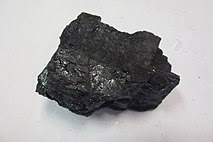 Wildfires have been a natural part of the ecosystem since the beginning of time. Fossilized charcoal shows that the first wildfires occurred approximately 419 million years ago, soon after the first terrestrial plants evolved. The fact that areas that have frequent wildfires have higher species richness and diversity than unburned old forest areas indicates that fires benefit ecosystems. However, what is good for the forest is not always good for man. Man’s intervention has led to changes in the fires themselves. New Mexico, like much of the American West, possesses characteristics that make wildfires common. In prehistoric times, the area’s volcanism might have contributed to burns. Now, the most common non-human cause of fires is lightning. Climatic cycles also contribute to the likelihood of wildfires. The heavy rains and deep snows of wet periods create crowded stands of small trees and thick underbrush. These become fuel during periods of drought. This fuel allows the naturally occurring ground fires to become the high-intensity crown fires. In 1872, Yellowstone, the world's first national park, was established. Fifteen years later, the U. S. Army was assigned the responsibility for its protection. The Army did not have enough soldiers to fight all of the naturally occurring fires and concentrated on those that were close to roads or human habitation. However, several deadly fires, most notably the 1871 Peshtigo Fire, which killed more than 1,500 people, the 1889 Santiago Canyon Fire, and the 1910 Great Fire made the public believe that all fires were bad. In 1916, the National Park Service took over park management from the Army and fire suppression became the only fire policy for the next fifty years.  In the 1960s, the government changed its policy. It once again recognized fire as a necessary ecological process. Fires were to be allowed to run their courses as long as they could be contained within fire management units and accomplished approved management objectives. Controlled burns were established to reduce the low-level fuels, keeping fires from becoming crown fires. However, fires, both natural and man made, do not always follow government rules.  Jennifer Bohnhoff's next book, Summer of the Bombers, tells the story of a girl who loses everything as a result of a controlled burn that jumps the barriers and races through her town. Scheduled to be published on April 10, it is available to preorder in digital form on Amazon or in paperback directly through the author. 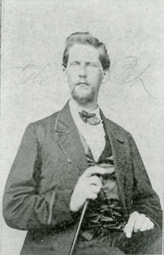 When historians want to know what it was like to be part of the Confederate invasion of New Mexico, one of the people they turn to is Alfred Brown Peticolas. Peticolas was was born on May 27, 1838, in Richmond, Virginia.. In 1859, he came west to Victoria, Texas, where he set up a law partnership with Samuel White. On September 11, 1861, he joined the Confederate Army. Peticolas enlisted in Company C of the Fourth Regiment of Texas Mounted Volunteers,. This was part of Henry Hopkins Sibley's Army of New Mexico, a brigade with which Sibley intended to capture the rich Colorado gold fields, then secure the gold and harbors of California for the Confederacy. Throughout his time in New Mexico, Peticolas kept a diary in which he set down his keen observations about the country through which he traveled. He was also an artist and sketched his surroundings. The diary filled several books, the first of which was destroyed when the wagon in which is was stored was burned. He also drew San Felipe church, in Albuquerque's Old Town. In his sketch, the Confederate flag flies from a flag pole in the center square of the village, right in front of the church. The Confederate, Mexican, Spanish, and American flags, flew over Albuquerque's Old Town representing all the governments that had controlled the town. In 2015, deemed too controversial, the stars and bars were taken down. Departing Albuquerque, Peticolas' unit traveled through Tijeras Canyon, then turned north, taking the road now known as N14 towards Santa Fe. They camped for over a week in the mountain village of San Antonio. The church, the building at the far left of the picture, burned down and was rebuilt in 1957. The Confederate tents and wagons are on the far right of the picture. After Sibley's retreat back to San Antonio Texas, Peticolas participated in the Louisiana Campaign. Finally, illness led to his reassignment as a clerk at the quartermaster headquarters, and he finished the war behind a desk.  Rebels on the Rio Grande: the Civil War Journal of A.B. Peticolas, edited by Don E. Alberts, University of New Mexico Press, Albuquerque, New Mexico, 1984 is a compilation of the passages from the diary that related to New Mexico. While he is not represented in Jennifer Bohnhoff's trilogy of novels about the Civil War, his material was instrumental in shaping the narrative and illuminating it with the little details that make historical fiction feel accurate.  Jennifer Bohnhoff is an author and educator who lives very close to the mountain town that Peticolas sketched. Where Duty Calls the first novel in her triloogy Rebels Along the Rio Grande, came out in 2022. The second, The Worst Enemy, will be published in the summer of 2023. I am blessed to be in a women's hiking group. We meet once a week and go a lot of interesting places. Since we all live in the greater Albuquerque area, most of or hikes are in or around the Sandia Mountains, the mountains that are in the background of this blog's header. Right now, most of our favorite trails are under a foot or more of snow. While we do use snowshoes on occasion, often we use the snowy season to go other places. One of the places we hiked this month was to see the Phoenician Stone, which is sometimes called the Decalogue Stone. Located at the base of a basalt- covered uplift about 35 miles southwest of Albuquerque and 15 miles west of Los Lunas, it is off the beaten track but well worth seeing if you are into curiosities and strange stories. 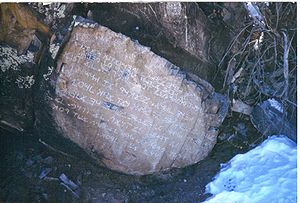 The Decalogue Stone was first mentioned by Frank Hibben (1910-2002), who was then an archaeology professor at the University of New Mexico. Hibben claimed that he was taken to the site in 1933, guided by a man who said he'd seen the stone as a boy back in the 1880s. Hibben was convinced that the inscription was ancient, and thus authentic. Some scholars have said that the writing is ancient Hebrew and is of the ten commandments, which is why it is sometimes called the Decalogue Stone. Others have announced that the writing is Phoenician and is an account of a shipwrecked sailor wandering in the desert. It's also been called Mystery Rock and the Los Lunas Inscription Stone. Some believe that it is a forgery created by members of the Mormon Battalion, who came through New Mexico during the Mexican–American War of 1846–1848. Others believe that Hibben or a couple of his graduate assistants created the stone. And, like most strange things in New Mexico, others suppose it is a record of aliens from outer space. Whatever its provenance, going to see it was a great thing to do on a cold, January day! We left our cars outside the Valencia County Landfill and hiked in over a dirt ranch road until we got to the base of Hidden Mountain, where we turned and walked up a ravine until we got to the stone. In the picture below, the stone is on the left, right in front of the woman on the far left. The stone may be a hoax, but what's on the top of Hidden Mountain isn't. After a scramble up a ravine, we arrived on top, where we found a lot of petroglyphs and the ruins of an ancient settlement that might have been part of a string of look-out and way stations along an ancient trail from the Rio Grande to Acoma Pueblo. Also in the area is the Franklin Pottery Mound, where a large diversity of ancient pottery has been unearthed. Both the mound and the ruins are believed to be from between 1350 and 1500. It's pretty obvious why this site would be chosen as a look-out. The views were spectacular in all four directions. We even saw a small herd of deer (although some of us thought they were pronghorns) down below. There's something wonderful and a bit eerie about being in a place that was occupied hundreds of years ago. It makes me wonder what life might have been like back then. What did the people who lived there feel as they stood on the edge and looked out over the vastness? After we'd walked the whole upper portion, we went back down the ravine and had a little celebration. Two of us (including yours truly) had birthdays to celebrate. Jennifer Bohnhoff lives in the mountains of central New Mexico. She has written a number of novels for middle grade through adult readers and has two titles that will be published in 2023. Click here to join her email list and receive information about her books.
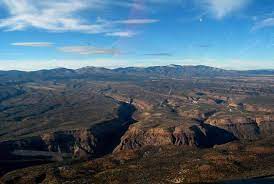 On the Parjarito Plateau, a volcanic plateau in the Jemez Mountains of north central New Mexico, large fires used to occur about every twenty years, following a natural climate cycle. Years of heavy rains and deep snows would lead to luxuriant growth of new trees and undergrowth, which would become natural fuel during drought years. Lately, the frequency and intensity of fires has increased, and so have their damage. Some of these fires have begun naturally, most frequently from lightning strikes. Others have been started by irresponsible people who've thrown a cigarette butt out the window of a moving car or left a campfire smoldering. The latest and most destrucive have begun as controlled burns that overstepped their bounds. Here are some of the most notable of the past eighty years. The first time a fire led to the evacuation of Los Alamos laboratories was in 1954. The Water Canyon Fire began as a trash and construction debris burn on June 5, 1954. High winds, including gusts up to 45 mph pushed the fire north. It burned out of control for several days before 1,000 firefighters and a drop in wind speed slowed it down. Between 3,000 and 6,000 acres of forest were lost. 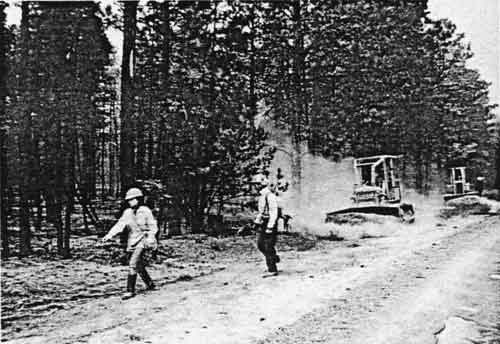 Archaeologists walk in front of bulldozers in an attempt to preserve and protect indigenous and early sites during the La Mesa fire. Archaeologists walk in front of bulldozers in an attempt to preserve and protect indigenous and early sites during the La Mesa fire. On June 16 1977, the La Mesa fire began. It took a week and over 1,300 personnel to contain the fire that investigators believe began with a spark from a motorcycle. The fire reached K-site and S-site, two facilities in Los Alamos National Laboratory used to fabricate and test chemical explosives, and burned 15,444 acres of Bandelier National Monument. Approximately 60% of the drainage basin of Rio de Los Frijoles, a tributary of the Rio Grande, was burned, leading to severe erosion when the monsoons began later that summer.  The Dome Fire, seen from Los Alamos The Dome Fire, seen from Los Alamos In 1996, the Dome Fire began on April 26, when two campers left a campfire burning. By the time it was controlled, it had burned over 16,500 acres and threatened the southern section of Los Alamos National Laboratory. Large areas of Capulin Canyon and the Dome Wilderness were charred. The fire sent flames hundreds of feet into the air and developed a spectacular plume that could be seen for miles. Over 800 firefighters fought this blaze. 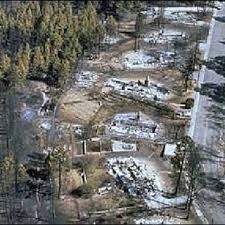 Two years after that, the Cerro Grande Fire began in May 2000 as a controlled burn that was supposed to reduce fire danger in Bandelier National Monument. High winds and dry conditions led the fire to jump its bounds. The fire destroyed over 400 homes in Los Alamos and damaged or destroyed several structures at Los Alamos National Laboratory. Over 43,000-acres were charred.  Two years later, the Oso Complex Fire was intentionally started by a man as a protest against government officials whom he claimed were using environmental laws to displace the poor, Hispanic population. Begun on June 20, 1998, the fire burned 5,185 acres of National Forest, including over 1,200 acres owned by Santa Clara Pueblo. It came within 8 miles of Los Alamos before rains and over 800 fire fighters, many of whom were Native Americans, were able to stop it. The arsonist pled guilty and was given a seven-year sentence in federal prison.  When it happened in 2011, the Las Conchas Fire was the largest wildfire the state of New Mexico had ever seen. It began on June 26, 2011 when an old, dead aspen tree blew into a power line. Driven by strong and unpredictable winds, the fire burned more than 150,000 acres of Pajarito Plateau and threatened the Pajarito Mountain Ski Area, the town of Cochiti, Los Alamos, and Santa Clara Pueblo. It was surpassed in 2012 by the much larger Whitewater-Baldy Complex Fire and in 2022 by the Calf Canyon/Hermits Peak Fire and the Black Fire. The 2022 Calf Canyon/Hermits Peak Fire burned 341,471 acres and blazed from early April to late June. This fire, was in the southern Sangre de Cristo Mountains, and not on Parjarito Plateau. Part of the record-breaking 2022 wildfire season, it was the largest wildfire of 2022 in the contiguous United States and destroyed or damaged nearly a thousand structures, including several hundred homes. The fire began as two separate wildfires, both of which were U.S. Forest Service prescribed burns. It was not fully contained until August 21. However they are started, wildfires in New Mexico cause terrible damage and stress to its residents, who live in fear both for their property and their lives. As climate change dries out the forests, we must all be even more vigilant.  Jennifer Bohnhoff is a former English and history teacher who lives in a remote spot in the mountains of central New Mexico.The local fire department has told her that her own house is unlikely to be saved in a wildfire. Her next novel, Summer of the Bombers, will be released in April 2023. Set in the fictitious town of Alamitos, it tells the story of a young woman whose life becomes chaotic after a controlled burn goes rogue and destroys her house. It is based loosely on the Cerro Grande fire of 2000. You can read more about her and her books here. |
Don't see what you're looking for?
I am in the process of moving all my blog entries to a different blog site. Eventually, this page will go away. If you're looking for something and it's not here, try my new site, or email me and suggest I write a blog on the topic you are interested in. 
ABout Jennifer BohnhoffI am a former middle school teacher who loves travel and history, so it should come as no surprise that many of my books are middle grade historical novels set in beautiful or interesting places. But not all of them. I hope there's one title here that will speak to you personally and deeply. Categories
All
Archives
March 2025
|
